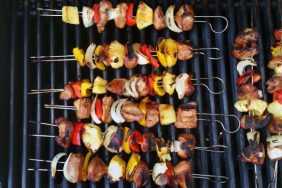Between the two of us, either my friend or I have pretty well sussed where we’re headed, and what we might do there. Not this time. We’ve booked a night at Hipping Hall for its location. It’s a good mid-way point from Scotland back to London to break up the seven-hour drive. Except neither of us quite know where it is, exactly. The website says it’s between England’s Lake District and the Yorkshire Dales, but now that we’re here, we realize there’s nothing ambiguous about it — we’re in the Yorkshire Dales. The landscape is all rolling hills punctuated by the odd church steeple.
Hipping Hall is a 15th century stone building which used to house a blacksmith before a later owner married the daughter of a local lawyer, becoming proper “gentry.” He left the hall as a legacy and it’s now an intimate hotel with just nine rooms.
It’s a cold Saturday, and we’re shown to the sitting room where small coal fire is surrounded by comfortable couches, a pick of the day’s papers and wonderful jazz playing just loud enough. A welcome cuppa’ and cake is soon set on a side table while we tuck in to the Times.
Hipping Hall is miles from a major city, and like most country hotels, they offer dinner in the gothic dining room. It’s mostly couples, but we’re one of two sets of gal pals, which makes us more comfortable amidst all the romance.
Warm, fresh baked bread takes the edge off before we’re presented with a dish of pork belly accompanied by orange and chicory, flavors more subtle than overpowering. Yorkshire goat’s curd arrives in the form of two bubble-gum shaped balls, deep fried with a soft, salty centre. White and red beetroot and candied walnuts balance the flavor, along with a lovely dollop of burrata.
We’re torn between the halibut and the vegetarian field mushroom duxelles, so we agree to share both. The mushrooms are tasty and unusual, but need a light jus or broth to enhance the flavor, and the small fried cheese balls we first found enchanting, are less so as they make a third appearance. But the halibut is better than many I’ve had at top London restaurants. It’s a perfectly flavored dish which marries mushrooms, an emulsion, and artichokes brilliantly.

We’re perhaps too accustomed to poor service in the UK, particularly once we leave the confines of the Big Smoke, but that’s where Hipping Hall shines. The same small staff that runs the hotel also work the dining room. They seem to get to know each guest (but not too much), and are very responsive. Every time we fail to leave a dish empty (which isn’t very many); we’re asked if it was okay, if anything was “not quite right” with the dish. Spend some time in England and you’ll understand how unusual this is. It’s not just that they ask, it’s the way they ask. Say to a Brit, “Is everything okay?” and you can pretty much bet serious money the answer will be, “Oh yes, lovely thanks,” even if it was dog food on the plate. It’s a subtlety, but by asking if something wasn’t quite right, the waiter has a better chance of gently coaxing the customer to reveal what went wrong.
Travel through History at Battle of Bannockburn Visitor Centre
We keep it local with dessert, a sort of deconstructed rhubarb pudding. We’re informed it’s forced Yorkshire rhubarb. Little do they realize we wouldn’t be bothered if it was frozen, but we love the full disclosure. Two toasted mounds of marshmallow are set down with tiny drops of meringue, strips of rhubarb, and refreshing sorbet. It’s very tasty, but the best is yet to come.
We retire to the fire for a few mean rounds of backgammon over tea and petit-fours. Three small chocolates never tasted so good. After a three-course meal I’m too self-conscious to ask for more, but if these came in a box, I’d have bought more than one to take back. The cream content is so high; they practically melt in our fingers.
Breakfast in the dining room with the Sunday papers is heavenly. The croissants are warm, the eggs delicately scrambled. And we’re off to see Kirkby Lonsdale, just a few minutes’ drive away. We know nothing about it, but quickly learn it’s a market town (code for quaint). We’re instantly charmed by the old fashioned sweets shop, Ruskin’s view (a sweeping view of the hills which the author pointed out to Turner, who later painted it), and a street lined with a handful of independent boutiques. It’s the sort of shopping that convinces one to leave London; terrific things at a fraction of city prices.
Our little detour may convince us to give up the train and drive toward Scotland more often.








